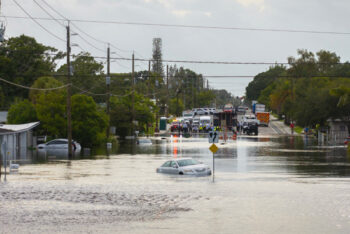AAA: beware of flood damaged cars
VW independent staff/submitted information
During the month of July, 1,434 flash flood warnings were issued, the second-highest July total in 40 years. Flood warnings have been issued in communities across the United States at a record rate since the modern alert system went into effect 40 years ago. This week, Hurricane Erin caused high water flooding problems along much of the eastern seaboard.
Vehicles across the country have been trapped in rising and rushing flood waters this year. Even partially submerged cars can be unsafe to drive and nearly impossible to identify and now, AAA is warning car buyers to be on the lookout for flooded out vehicles that may have made their way to the used car market.

“Modern vehicles have much more technology on board than ever before,” AAA spokesperson Kara Hitchens said. “Many cars have safety features in the wiring systems, sensors and electronic modules running throughout the vehicles, including behind the bumpers and fenders. Water intrusion into those systems can cause serious, costly and potentially unrepairable damage.”
The engine and many other mechanical components can be heavily damaged or inoperable due to water as well. The cost of repairing flood damage is often more than the value of the vehicle itself and insurance will declare it a total loss.
Flood-damaged vehicles are typically given a salvage or flood title (depending on the state) and recycled for parts or crushed for scrap, but some end up on the used car market – and could end up in your driveway.
“The seller may have made some repairs to get the vehicle running and looking nice, but there could be hidden problems that will eventually catch up with the new buyer,” Hitchens said.
Follow these steps to avoid a flood-damaged car:
- Choose a reputable car dealer.
- Smell for mold or mildew.
- Check upholstery and door panels for water stains, mud, rusted screws and components or new or mismatched fabric/carpeting.
- Search the trunk and under carpets for dirt, sand, mildew or other signs of water or water damage.
- Scrutinize the seatbelts for mildew, water spots and dirt. Pulling the belt all the way out may reveal tell-tale watermarks or other signs of water intrusion.
- Test electrical components, including window and seat controllers, turn signals, radio and A/C.
- Look for rust inside the hood and around doors, hinges and screws.
- Check for fog or moisture inside headlights, taillights and turn-signal lights.
Get a free report on the vehicle. Visit the National Insurance Crime Bureau website for a free VINCheck. Just type in the Vehicle Identification Number to find out whether the car you are interested in buying was ever reported as a salvage or flood vehicle by insurance companies that belong to the NICB. Be aware that VIN fraud, where VIN numbers are switched or altered, can occur.
- Purchase a CARFAX report for even more detailed information about the car, including major accidents, number of previous owners, mileage rollbacks and manufacturer recalls.
- Have a mechanic do a thorough inspection.
- If a deal seems too good to be true, it’s often an indicator that the seller is trying to get rid of a car that’s likely to have problems in the future.
“It can take many months to over a year for flood-damaged cars to make their way to market,” Hitchens said. “Buyers should always thoroughly inspect vehicles before purchasing.”
Would you know what to do if your car floods?
With some summer and much of hurricane season still in front of us, many more cars are at risk of becoming flood-damaged this year. Dealing with a flooded vehicle may be much more than just an inconvenience, it could represent a significant expense or a total loss. Damage caused by floodwater is only covered for drivers who have the optional comprehensive coverage as part of their auto policy.
- When dealing with an automobile that has been in a flood, the first step should be to contact your insurance company (provided you have comprehensive coverage) for help in determining the best course of action.
- Call a repair facility for guidance and to see if they are accepting flood-damaged vehicles before arranging for a tow.
- Take photographs of any visible damage, including water inside and around the vehicle if you can safely do that.
Do not attempt to start the vehicle. If the engine compartment was underwater and the car was parked do not attempt to start the car as the engine will have taken in water which will cause engine damage. Before attempting to start a flood-damaged car, a qualified technician should:
- Inspect all readily accessible mechanical and electrical components, and systems that contain fluids, for water contamination.
- Drain floodwater from contaminated components and systems, flush with clean water or an appropriate solvent, and refill with new clean fluids of the proper type.
- Inspect, clean, and dry electrical system components and connections.
POSTED: 08/23/25 at 12:35 am. FILED UNDER: News







